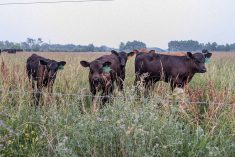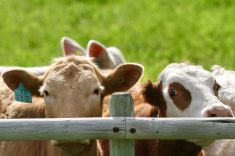Cattle producers sometimes find it necessary to castrate bulls at weaning time. They may have bought the calves as backgrounders or feeder cattle or perhaps they didn’t have access to the calves at a younger age.
In some cases, seed stock producers may not decide which males to keep as potential breeding bulls until weaning time or later.
We would prefer to castrate at a much younger age, if possible. This is a painful procedure and the pain and amount of healing time are minimized by doing it at one or two months of age or younger.
Read Also

U.S. farm group supports supply management
U.S. grassroots farm advocacy group pushing new agriculture legislation that would move towards supply management like Canada has for dairy industry
In terms of animal welfare, it is the best time to perform this chore so castrating at a younger age should be the goal of most commercial cow-calf producers.
Two alternatives are available when castration is necessary in an older calf: surgical castration and banding.
Surgical castration is effective but carries risks.
It is a painful procedure and pain control of some form should be used, especially in older calves. It can be an injection of a non-steroidal anti-inflammatory drug that helps reduce inflammation and swelling and also provides temporary pain relief.
Local anesthesia is difficult to provide, although a veterinarian can use various forms of epidural anesthesia, which are injected into the epidural space around the spine, near the tail head.
This technique requires training and at least five minutes to take effect, which makes it less practical in some situations.
The other risks associated with surgical castration are mostly postsurgical complications. These older calves are more likely to bleed after surgery and a small percentage can die from post-surgical bleeding.
The other post-surgical castration risk is possible infection. Many of these can be treated with antibiotics, but an open surgical wound in a muddy environment is always at risk of becoming infected.
The key to preventing post-surgical castration infections is adequate clean bedding and ensuring that the incision site is large enough to allow adequate drainage.
Surgical castration is also risky for the operator. Using a sharp instrument such as a scalpel in the vicinity of the hind end of a 500 pound calf can be risky business.
Significant injuries have occurred when calves have kicked or jumped at the wrong time, causing loss of control of a sharp instrument.
The Newberry Knife is an alternative to the scalpel. It has a protected blade that allows the operator to be much safer when making the incision.
The alternative to surgical castration is an instrument to band calves.
The banding instrument is designed to clamp a small band of surgical tubing around the neck of the scrotum above the testes, which stops the blood flow and eventually causes the testicles and scrotum to fall off.
The procedure seems to be less painful at the time of application but certainly still causes pain to the animal after application. Pain control such as anti-inflammatory drugs should be considered in these older calves.
The procedure is certainly safer for the operator because no sharp instruments are involved and the animal does not react significantly to the initial placement of the band.
There are potential complications. If the band is not made tight enough, the outgoing blood flow will be clamped off but the incoming arterial blood will still flow into the tissues.
This will result in severe swelling of the scrotum and require a second tighter band to be placed above the first band once the swelling is noticed.
As well, animals can die from tetanus if unprotected by vaccinations. Tetanus is a rare occurrence in cattle, but the one situation where it frequently occurs is in older calves that are castrated using the banding method.
It usually occurs one to two weeks after the bands are applied. Animals may initially adopt a stiff sawhorse posture and will eventually go down on their sides and be unable to rise. Their limbs and tail are held out stiffly and eventually they will suffer convulsions and die.
Tetanus is prevented by vaccinating animals before or at the time of castration with a clostridial vaccine that contains tetanus.
Many of the clostridial vaccines marketed in Canada do not include tetanus, so check with your veterinarian.
Several studies have evaluated which of these techniques is the most welfare friendly. In my opinion, it is somewhat of a toss up.
The surgical procedure is more painful at the time of castration but probably heals more rapidly and results in a shorter-term pain. Banding causes less pain at the time of the procedure but will take up to a month before the healing is complete.
Banding probably has advantages in terms of fewer complications and operator safety, but producers should avoid castrating older calves whenever possible.
John Campbell is head of Large Animal Clinical Sciences at the University of Saskatchewan’s Western College of Veterinary Medicine.














